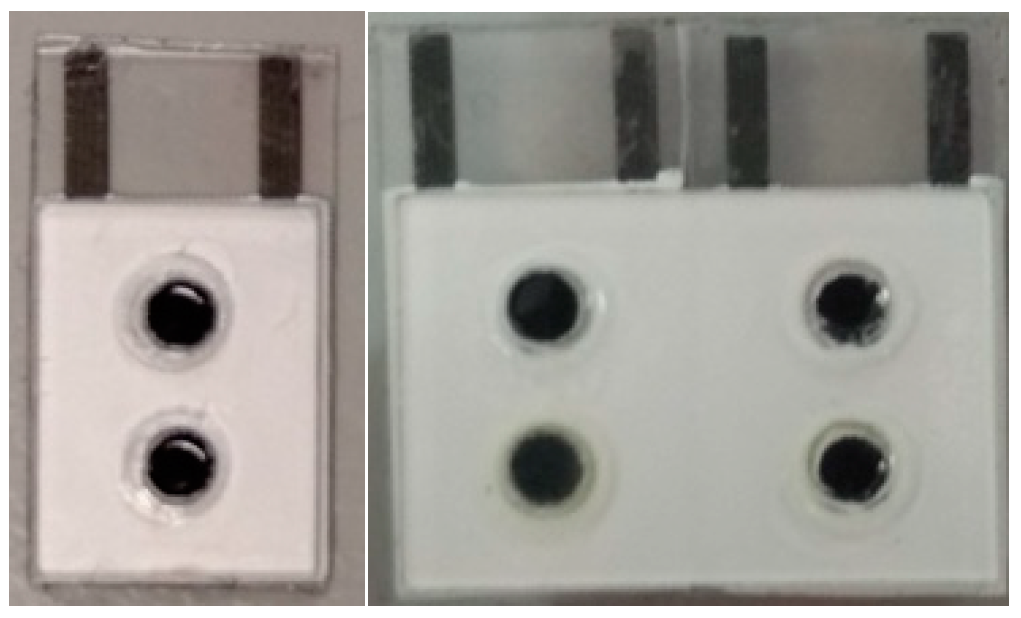Real-time Analysis of Electrolytes in Sweat Through a Wearable Sensing Platform †
Abstract
:1. Introduction
2. Materials and Methods
2.1. Materials
2.2. Instrumentation
2.3. Electrodes Fabrication
3. Results and Discussion
3.1. Electrodes Fabrication and Response
3.2. Multiple Analyte Platform
4. Conclusions
Author Contributions
Funding
References
- Heikenfeld, J.; Jajack, A.; Rogers, J.; Gutruf, P.; Tian, L.; Pan, T.; Li, R.; Khine, M.; Kim, J.; Wang, J.; et al. Wearable sensors: modalities, challenges, and prospects. Lab Chip 2018, 18, 217–248. [Google Scholar] [CrossRef]
- Scurati-Manzoni, E.; Fossali, E.F.; Agostoni, C.; Riva, E.; Simonetti, G.D.; Zanolari-Calderari, M.; Bianchetti, M.G.; Lava, S.A.G. Electrolyte abnormalities in cystic fibrosis: systematic review of the literature. Pediatr. Nephrol. 2014, 29, 1015–1023. [Google Scholar] [CrossRef] [PubMed]
- Zilberstein, G.; Zilberstein, R.; Maor, U.; Righetti, P.G. Noninvasive wearable sensor for indirect glucometry. Electrophoresis 2018, 39, 2344–2350. [Google Scholar] [CrossRef] [PubMed]
- Parrilla, M.; Cuartero, M.; Crespo, G.A. Wearable Potentiometric Ion Sensors. Trends Anal. Chem. 2019, 110, 303–320. [Google Scholar] [CrossRef]
- Glennon, T.; O’Quigley, C.; McCaul, M.; Matzeu, G.; Beirne, S.; Wallace, G.G.; Stroiescu, F.; O’Mahoney, N.; White, P.; Diamond, D. ‘SWEATCH’: A Wearable Platform for Harvesting and Analysing Sweat Sodium Content. Electroanalysis 2016, 28, 1283–1289. [Google Scholar] [CrossRef]
- McCaul, M.; Porter, A.; Barrett, R.; White, P.; Stroiescu, F.; Wallace, G.; Diamond, D. Wearable platform for real-time monitoring of sodium in sweat. Chemphyschem 2018, 19, 1531–1536. [Google Scholar] [CrossRef] [PubMed]
- Zuliani, C.; Matzeu, G.; Diamond, D. A liquid-junction-free reference electrode based on a PEDOT solid-contact and ionogel capping membrane. Talanta 2014, 125, 58–64. [Google Scholar] [CrossRef] [PubMed]
- Zuliani, C.; Matzeu, G.; Diamond, D. A potentiometric disposable sensor strip for measuring pH in saliva. Electrochimica Acta 2014, 132, 292–296. [Google Scholar] [CrossRef]
- Xiao, K.P.; Bühlmann, P.; Nishizawa, S.; Amemiya, S.; Umezawa, Y. A Chloride Ion-Selective Solvent Polymeric Membrane Electrode Based on a Hydrogen Bond Forming Ionophore. Anal. Chem. 1997, 69, 1038–1044. [Google Scholar] [CrossRef]
- Montain, S.J.; Cheuvront, S.N.; Lukaski, H.C. Sweat Mineral-Element Responses during 7 h of Exercise-Heat Stress. Int. J. Sport Nutr. Exerc. Metab. 2007, 17, 574–582. [Google Scholar] [CrossRef] [PubMed]


Publisher’s Note: MDPI stays neutral with regard to jurisdictional claims in published maps and institutional affiliations. |
© 2019 by the authors. Licensee MDPI, Basel, Switzerland. This article is an open access article distributed under the terms and conditions of the Creative Commons Attribution (CC BY) license (https://creativecommons.org/licenses/by/4.0/).
Share and Cite
Pirovano, P.; Shinde, A.; White, P.; Wallace, G.; McCaul, M.; Diamond, D. Real-time Analysis of Electrolytes in Sweat Through a Wearable Sensing Platform. Proceedings 2019, 15, 14. https://doi.org/10.3390/proceedings2019015014
Pirovano P, Shinde A, White P, Wallace G, McCaul M, Diamond D. Real-time Analysis of Electrolytes in Sweat Through a Wearable Sensing Platform. Proceedings. 2019; 15(1):14. https://doi.org/10.3390/proceedings2019015014
Chicago/Turabian StylePirovano, Paolo, Akshay Shinde, Paddy White, Gordon Wallace, Margaret McCaul, and Dermot Diamond. 2019. "Real-time Analysis of Electrolytes in Sweat Through a Wearable Sensing Platform" Proceedings 15, no. 1: 14. https://doi.org/10.3390/proceedings2019015014
APA StylePirovano, P., Shinde, A., White, P., Wallace, G., McCaul, M., & Diamond, D. (2019). Real-time Analysis of Electrolytes in Sweat Through a Wearable Sensing Platform. Proceedings, 15(1), 14. https://doi.org/10.3390/proceedings2019015014




